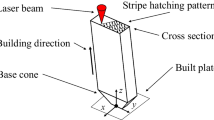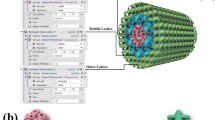Abstract
We have developed a novel specimen for studying crack paths in glass. Under certain conditions, the specimen reaches a state where the crack must select between multiple paths satisfying the K II = 0 condition. This path selection is a simple but challenging benchmark case for both analytical and numerical methods of predicting crack propagation. We document the development of the specimen, using an uncracked and instrumented test case to study the effect of adhesive choice and validate the accuracy of both a simple beam theory model and a finite element model. In addition, we present preliminary fracture test results and provide a comparison to the path predicted by two numerical methods (mesh restructuring and XFEM). The directional stability of the crack path and differences in kink angle predicted by various crack kinking criteria is analyzed with a finite element model.
















Similar content being viewed by others
References
Goldstein RV, Salganik RL (1974) Brittle fracture of solids with arbitrary cracks. Int J Fracture 10:507
Erdogan F, Sih GC (1963) On the crack extension in plates under plane loading and transverse shear. J Basic Eng-T ASME 85:516
Sih GC (1973) Some basic problems in fracture mechanics and new concepts. Eng Fract Mech 5(2):365
Sih GC (1974) Strain-energy-density factor applied to mixed mode crack problems. Int J Fracture 10(3):305
Cotterell B (1965) On brittle fracture paths. Int J Fract Mech 1:96
Wu CW (1978) Maximum energy release rate criterion applied to a tension-compression specimen with crack. J Elasticity 8(3):235
Williams ML (1957) On stress distribution at base of stationary crack. J Appl Mech 24(56):109
Rubinstein AA (1990) Crack-path effect on material toughness. J Appl Mech 112:97
Rubinstein AA (1991) Mechanics of the crack path formation. Contractor Report 185143 NASA
Rubinstein AA (2003) Computational aspects of crack path development simulation in materials with nonlinear process zone. Int J Fract 119:L15
Bittencourt TN, Wawrzynek PA, Ingraffea AR, Sousa JL (1996) Quasi-automatic simulation of crack propagation for 2D LEFM problems. Eng Fract Mech 55(2):321
Moës N., Dolbow J, Belytschko T (1999) A finite element method for crack growth without remeshing. Int J Numer Meth Eng 46(1):131
Hakim V, Karma A (2009) Laws of crack motion and phase-field models of fracture. J Mech Phys Solids 57(2):342
Cotterell B, Rice JR (1980) Slightly curved or kinked cracks. Int J Fracture 16(2):155. doi:10.1007/BF00012619
Yang B, Ravi-Chandar K (2001) Crack path instabilities in a quenched glass plate. J Mech Phys Solids 49 (1):91. doi:10.1016/S0022-5096(00)00022-3
Micro-Measurements (2010) Measurement of thermal expansion coefficient using strain gages. Tech. Rep. TN-513-1 Vishay precision group
Micro-Measurements (2014) Strain gage thermal output and gage factor variation with temperature. Tech. Rep. TN-504-1 Vishay precision group
AIH Committee Metals Handbook, vol. 1, 10th edn (ASM International 1990)
Corning Inc. Properties of PYREX®;, PRYEXPLUS®;, and low actinic PYREX code 7740 glasses
(2007). Hexion. Technical data sheet, Epikurecuring agent 3140. www.hexion.com/Products/TechnicalDataSheet.aspx?id=2654
(2005). Technical data sheet, Hysol Product U-05FL
SIMULIA, ABAQUS Analyis User’s Guide, 6th edn. (2014). Section 22.5.1
Ramesh K (2000) Digital photoelasticitiy. Springer
Suo Z, Hutchinson JW (1989) Steady-state cracking in brittle substrates beneath adherent films. Int J Solids Struct 25(11):1337
SIMULIA (2014) ABAQUS Analyis User’s Guide 6th edn
Kayashi K, Nemat-Nasser S (1981) Energy-release rate and crack kinking under combined loading. Trans of the ASME 48:520
Melin S (1994) Accurate data for stress intensity factors at infinitesimal kinks. J Appl Mech 61:467
He M, Bartlett A, Evans AG, Hutchinson J.W (1991) Kinking of a crack out of an interface: role of in-plane stress. J Am Ceram Soc 74(4):767
Amestoy M, Leblond JB (1992) Crack paths in plane situations – II. Detailed form of the expansions of the stress intensity factors. Int J Solids Struct 29(4):465
Zehnder AT Fracture Mechanics (Springer, 2012), Lecture Notes in Applied and Computational Mechanics, vol 62, chap. 4.3.4
Sandia National Laboratories (2015) Sierra/solidmechanics User’s Guide 4th edn
Fracture Analysis Consultants Inc (2016) FRANC3D Reference Manual, 7th edn
Acknowledgements
The authors thank Garth Rohr and Corey Gibson for assistance with experiments, John Laing for valuable strain gage discussions, and John Emery for assistance with FRANC3D crack propagation calculations. Sandia National Laboratories is a multimission laboratory managed and operated by National Technology and Engineering Solutions of Sandia, LLC, a wholly owned subsidiary of Honeywell International, Inc., for the U.S. Department of Energy’s National Nuclear Security Administration under contract DENA0003525.
Author information
Authors and Affiliations
Corresponding author
Rights and permissions
About this article
Cite this article
Grutzik, S., Reedy, E. Crack Path Selection in Thermally Loaded Borosilicate/Steel Bibeam Specimen. Exp Mech 58, 1–10 (2018). https://doi.org/10.1007/s11340-017-0297-8
Received:
Accepted:
Published:
Issue Date:
DOI: https://doi.org/10.1007/s11340-017-0297-8




